Mayor De Blasio: Restore Funding to Summer Youth Employment for Teens Who Need It, Like Me
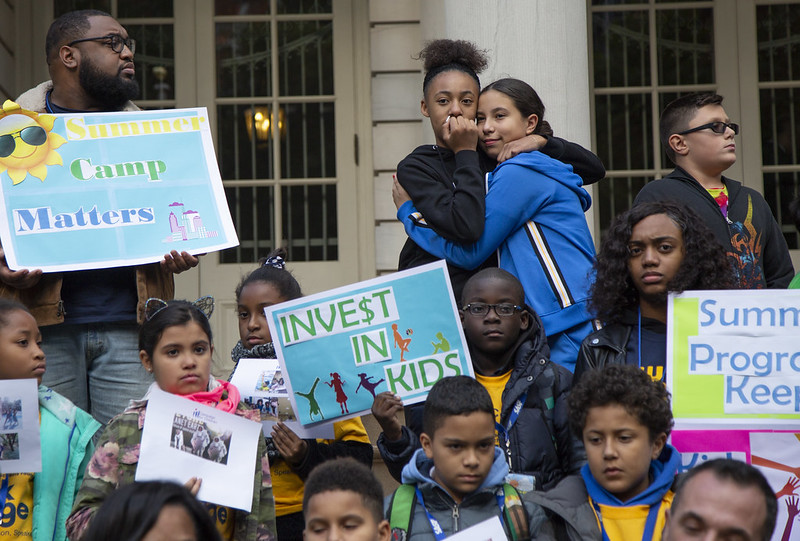
Tens of thousands of young New Yorkers rely on SYEP (photo: John McCarten/City Council)
When I first heard of the New York City Summer Youth Employment Program (SYEP) two years ago, I had just turned 14. I was so excited because that Fall I would enter high school and my family needed money to help pay for my uniform, school supplies, and books. Like a lot of New York families, money was already tight, so the prospect of getting a job where I could help my parents even just a little was an incredible opportunity.
Over the last two summers, SYEP has been a great experience that not only helped me make some money, but also helped prepare me for a better future. Before Mayor de Blasio announced he would be cutting SYEP funding this year as a result of coronavirus, I was already accepted for the summer of 2020, an opportunity I no longer have unless the city undoes that budget cut.
Before SYEP, I wasn’t sure what I wanted to pursue in college and possibly beyond. Then, last summer, I worked at State Farm, which helped me realize how much passion I had for business, finally giving me an idea of what I wanted to study. Through SYEP, I also entered the Work Learn Grow program, which gave me my start working in a social work environment -- a shelter, which completely changed my perspective on life, work, and society.
Through Work Learn Grow, I started working at Praxis Enterprise. Having small parties and celebrations for families living in the shelter brought me joy. Coming into work every day and hearing “Hi Leny! I missed you! Is there after school today?” made me happy. I could have had a bad day but knowing how much I can brighten someone's day - -even through their hardships -- was motivating in a whole new way.
It’s no secret that life for us all under quarantine has been difficult. Not being able to go outside, see my friends, or even go to school has taken a toll on me. I feel for those who have depression like me. I feel for those who are struggling to make ends meet. Sadly, I know I’m not alone. All of which is why I can’t help but think of the tens of thousands of teens just like me who would benefit from having the SYEP now more than ever, especially those whose family members have lost work because of the virus.
For the thousands of parents who don’t have a job, their children could help to fill the void of onerous expenses. Countless families could be saved using SYEP as a way to bring food to the table, transportation money, and to contribute to rent or other household needs.
But SYEP is about so much more than just a summer paycheck. It’s about getting the opportunity for real-world work experience so many thousands of us teens wouldn’t otherwise get. Being in SYEP helped me build my resume, which will help me for years to come as I apply to college and pursue other opportunities. SYEP, even if conducted remotely, still has the enormous potential to help teens like me far into our futures, beyond this summer. Without it, we risk falling much further behind our peers throughout the city.
If our school system of more than 1 million students could convert to remote learning in just a week, then surely there is a way to convert SYEP to provide remote jobs as well. Most students in New York City have electronic devices they can work on, many more so now that the city has been distributing devices for school purposes. This opportunity would be a huge help to the families who lost their main sources of income because of this pandemic.
I hope the mayor and City Council reverse course to help the youth of this city who were counting on summer employment opportunities even before this hard time set in, and need SYEP even more now. We depend on these jobs not just for this summer, but for our futures. Now is not the time to cut SYEP, now is when we need it most.
***
Karleny Ramos is a junior at the High School for Teaching and Professions in the Bronx and a member of Teens Take Charge. On Twitter @TeensTakeCharge.
***
Have an op-ed idea or submission for Gotham Gazette? Email This email address is being protected from spambots. You need JavaScript enabled to view it.
Healing the New York Region with Coordinated Planning
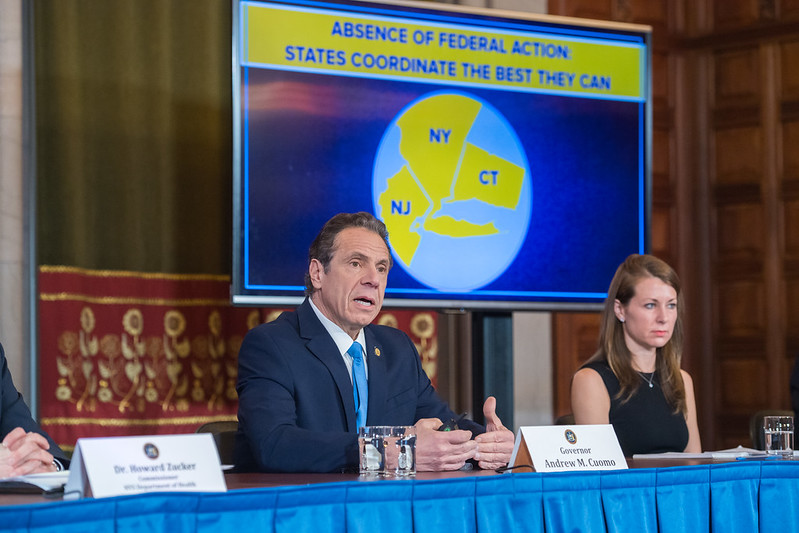
An argument for a regional approach to recovery (photo: Darren McGee/Governor's Office)
Even for a metropolitan area that experienced the trauma of September 11, 2001 and the devastation of Superstorm Sandy, nothing could prepare residents of New York and their neighbors in New Jersey and Connecticut for the COVID-19 crisis. The death toll has already far surpassed that of the World Trade Center attack and will continue to climb. The economic damage is certain to exceed the job and income losses of those events and the 2008 financial crisis combined. The impacts on our collective psyche won’t be fully known until well after the pandemic has passed.
More than even in those earlier disasters, the response to this crisis requires a coordinated effort from the states and communities that are intricately tied together in family, social, and business networks that use the same roads, trains, stores, offices, schools, parks, and public spaces, drink the same water, and breathe the same air.
The decision by Governors Cuomo, Murphy, and Lamont, and their fellow governors in four other northeastern states, to form a Regional Coronavirus Reopening Council is an unprecedented collaboration that is crucial to reopening their interdependent economies. The council can have an even greater impact if it lays the foundation of a coordinated, long-term strategy to build a region that is healthier, fairer, and more resilient.
Planning for the recovery needs to start with the realization that the region is very sick and still in intensive care. Easing stay-at-home orders and other restrictions too soon will result in more deaths, a likely return to lockdowns and a longer recovery.
Returning to full physical and economic health will also require treating the underlying conditions that made us so susceptible to this disease.
The vastly disproportionate impact that this has had on black, Latino, and Native American populations, and the racial profiling the has been targeting the Asian community, is rooted in our history of racism and segregation. The sharp divides between the affluent, the middle-class, and low-wage workers without benefits or savings is a glaring outcome of decades of growing economic inequality. High levels of air pollution and other environmental hazards have always been a health risk, and appear to make us particularly susceptible to serious coronavirus effects. The fragility of vital systems like the transit network and unemployment insurance is the result of decades of underfunding and a failure to modernize. Slow adaptation to climate change will lead to even greater vulnerability and inequity. Even immediate measures to restart the economy need to address these fundamental flaws.
All of these conditions are national in scope and call for a concerted national response. But both the unique character of the region and the scale of the epidemic here require a vision and plan for the tri-state metropolitan area at least, if not the entire Northeast. The governors, through the regional council, can set a course that both speeds recovery and begins fixing structural problems.
A starting point for the long view can be Regional Plan Association’s 2017 Fourth Regional Plan, a once-in-a-generation vision for the tri-state metropolitan area. Many of its recommendations will need to be reassessed in a post-COVID-19 world, but the long-term challenges addressed in the plan are, if anything, now more important to overcome. The values of health, equity, prosperity, and sustainability that shaped the plan can guide the actions we take at each stage of recovery and renewal.
As we transition to recovery, the immediate focus on coordinating guidelines for reopening and physical distancing can shift to incorporating health goals and metrics in all regional and state agencies. New York State’s health-in-all-policies guidelines are a good place to start. These will be particularly important in reducing the vast disparities in health outcomes by race and income.
A united effort to secure the region’s fair share of federal transit assistance is the first order of business to keep the region’s circulatory system from spiraling into decline, but why stop there? With support from the governors, the region’s transportation agencies could join in creating a universal fare-payment mechanism and start to integrate rail services to allow more direct, one-seat rides to different parts of the region.
The council could spearhead an effort to give affordable, reliable Internet service to every household in the region, eliminating a leading source of both urban and rural inequality while reducing the region’s vulnerability in future disasters. This could set the stage for more difficult but essential conversations on how to expand affordable housing and reduce segregation throughout the metropolitan area.
An economic restart may be our best opportunity to rebuild in a way that supports a healthier environment and greater resilience to both future pandemics and climate change. Interstate cooperation to reopen the economy can be a foundation for large-scale climate initiatives, such as expanding regional greenhouse gas reduction programs, scaling up renewable energy, and capitalizing adaptation trust funds.
Recovering from the coronavirus pandemic will require a mobilization of the region’s talents, resources, and political will to a degree not seen since at least the deep fiscal crisis of the 1970s. We have a chance to not only recover much of what we lost, but to heal the wounds and divisions that new calamities would otherwise exploit.
***
Chris Jones is Senior Vice President and Chief Planner at Regional Plan Association. On Twitter @RegionalPlan.
***
Have an op-ed idea or submission for Gotham Gazette? Email This email address is being protected from spambots. You need JavaScript enabled to view it.
Protect Democracy with Vote-by-Mail and Online Registration
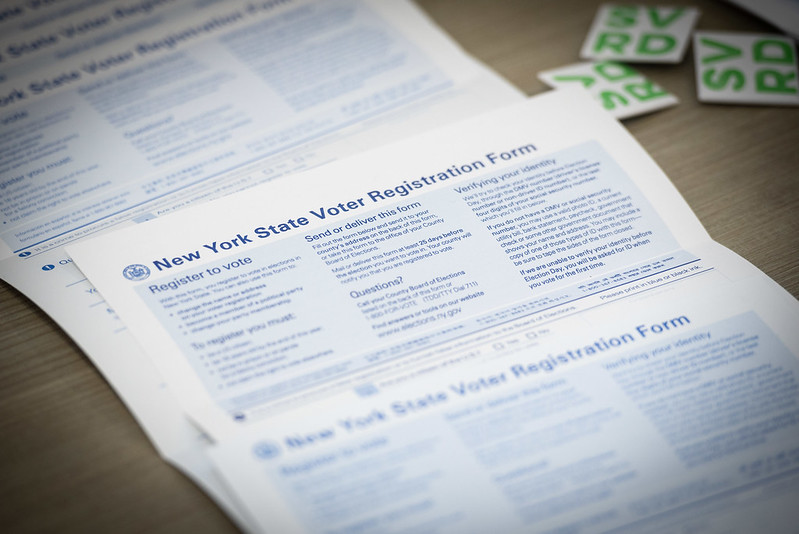
Next potential steps for voting in New York (photo: Michael Appleton/Mayor's Office)
The following is an excerpt from the 2019-20 NYC Votes Voter Analysis Report
Novel and frightening barriers to voting have the potential to upend the entire crucial 2020 election year in every state. The challenges of in-person voting during a pandemic are clear and significant. Elections traditionally provide a time for citizens to gather together in large numbers to engage in the practice of democracy. But restrictions on public gatherings recommended by public health authorities in response to the spread of COVID-19 cast regular poll site operations in a new light.
In jurisdictions around the country, many voters wait packed together in long lines to make their voices heard. Institutions that regularly serve as poll sites may be justifiably concerned about allowing potential carriers to pass through their doors—especially senior centers or schools. While early voting opportunities can provide space for voters to follow physical distancing guidelines, they offer no such protection to the dedicated poll workers who interact with each voter requesting a ballot.
In response, many election experts and advocates have advocated for prompt and widespread adoption of vote by mail.
Washington State, for instance, mails ballots to every registered voter 18 days before each election. Voters can mail their ballots back or return them to designated ballot drop boxes by the end of Election Day. Four other states—Colorado, Hawaii, Oregon, and Utah—conduct all-mail elections.
In New York State, mail-in or absentee voting is available only to voters who can attest to a specific reason they will be unable to appear at the polls, either for absence or illness. By executive order, Governor Cuomo expanded the meaning of “temporary illness” to cover those seeking to stem the spread of COVID-19, and mandated that every voter should receive an absentee ballot application in the mail. However, its effects are temporary. As issued, it applies only to elections through June 23. By whatever means are available, expanded access to vote by mail should be offered to New Yorkers on a permanent basis.
What we’ve learned in this moment is that universally-accessible vote by mail is not merely a turnout-boosting convenience. It can provide necessary resilience for our democratic system when the logistics of in-person balloting become impossible or impractical to maintain. It is one of a series of critical measures that should be available to administrators to ensure the continuity of our elections. New York should act promptly and decisively to implement it here.
The COVID-19 response effort is also shifting the way that organizers and campaigners approach the work of engaging voters. Traditional methods of registering voters will need to be rethought and campaign plans will need to be redesigned to adapt to the reality of an election year conducted during a pandemic. At minimum, a response that preserves New Yorkers’ access to elections through crises will require New York to finally end its reliance on a paper-based voter registration system that depends heavily on face-to-face interaction to bring new voters into the democratic process.
Times of crisis can force hard choices upon us; they demand we articulate our values and protect the things we value most. Elections are essential, particularly and especially in these difficult moments. In just the last twenty years, New Yorkers have come together to vote in the wake of a terrorist attack and in the aftermath of a destructive storm. Each instance demonstrates anew that our election laws and systems badly need flexibility to ensure elections can adapt effectively to public challenges like this one.
Democracy will persist — if we choose it.
***
Amy Loprest is the Executive Director of the NYC Campaign Finance Board, which runs the nonpartisan voter engagement initiative NYC Votes. Read the full 2019-20 NYC Votes Voter Analysis Report. On Twitter @NYCCFB & @NYCVotes.
***
Have an op-ed idea or submission for Gotham Gazette? Email This email address is being protected from spambots. You need JavaScript enabled to view it.
Aid to States is Important, But Next Federal Stimulus Must Truly Spark a People’s Recovery
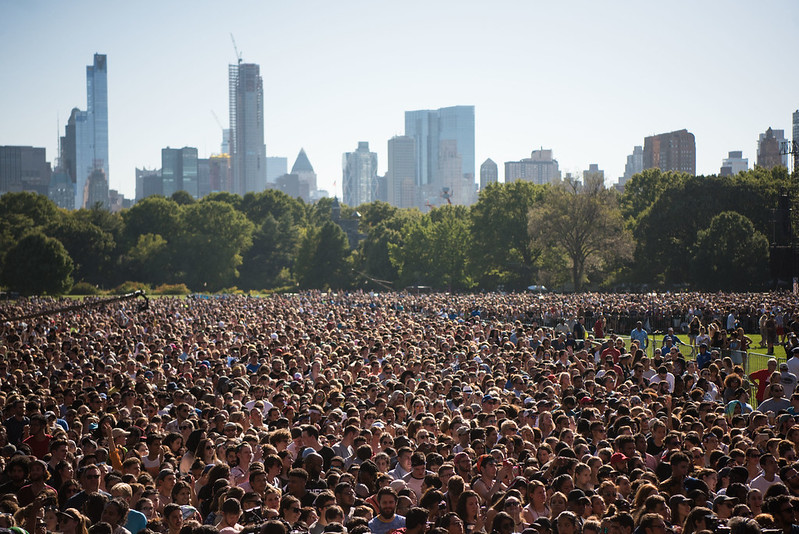
The people must be prioritized, the authors write (photo: Michael Appleton/Mayor's Office)
New York remains the epicenter of the fight against the COVID-19 pandemic. And we remain short of resources to tamp down transmission of the virus and to provide the critical economic relief to working families and the most vulnerable New Yorkers.
Our representatives in Congress need to make sure we get those resources in the next stimulus bill. And starting this week, we’ve been gathering New Yorkers from all across the state to join in the fight for a People’s Recovery that will benefit all of us.
It’s not just “PPE” -- personal protective equipment -- but also workplace protections, cash assistance, healthcare, housing aid, and safe housing for those of us who are homeless or incarcerated that are now essential to caring for our people and preventing more community transmission of the virus.
This crisis has laid bare the devastating inequality in our state and the failures of austerity policies that have left most of our communities woefully unprepared, while the wealthy and well-connected escape to well-stocked hideaways, where many of them profiteer on the pandemic.
The devastation has been hardest on communities of color, consistent with the systemic inequities in our education, healthcare, and economic systems.
Frontline workers -- many of whom are immigrants and all of whom don’t have the privilege to stay at home -- are putting their lives on the line to save our lives, deliver essentials, and keep food on all of our tables. Meanwhile, immigrant, homeless, and incarcerated communities have been largely left out of pandemic policies and planning.
The first three federal stimulus packages along with the latest supplementary package failed to deliver relief to those who need it the most. And our new state budget failed to reverse a decade of austerity, instead choosing cuts to critical pandemic response services over asking the wealthiest New Yorkers to chip in more.
Yes, we do need more unrestricted federal resources for state and local governments. But we also need more for regular New Yorkers struggling with the twin healthcare and economic impacts of the pandemic.
Senate Minority Leader Chuck Schumer and our congressional delegation must do better for New York.
We cannot accept another corporate-first stimulus package. We need a People’s Recovery that will regenerate society and tackle institutional inequality head-on. The next stimulus must:
Repair dangerous gaps in worker protections and address dangerous exclusion of immigrant families.
Provide ongoing and universal income assistance paired with true financial relief.
Provide healthcare to all and protections to health care workers.
Fix gaping holes in corporate accountability and state governmental oversight.
Allocate the money needed to protect our democracy and elections.
Address the unfolding public health crises around incarceration and homelessness.
Starting this week, community, labor, faith, and Indivisible groups across New York will be holding online teach-ins on each of these key priorities to kickstart the advocacy. We expect our lawmakers to attend, to learn, and to take action that will save lives now and over the long run.
And we also expect our legislators to get back to work.
Workers across the country are adjusting to the requirements of social distancing. Why hasn’t Congress? It’s time to reconvene and implement the necessary procedures and technology solutions to ensure a fully functioning and transparent government.
The on-again-off-again backdoor negotiations are opaque and undemocratic. And the results show what’s wrong with doing it that way: outrageous corporate bailouts, insufficient oversight, and millions of New Yorkers left to fend for themselves.
The time for New York’s Congressional delegation to stand up and fight for our communities is now.
***
Ricky Silver is co-lead organizer with Empire State Indivisible. Michael Kink is the executive director of the Strong Economy For All Coalition. On Twitter @es_indivisible & @mkink.
***
Have an op-ed idea or submission for Gotham Gazette? Email This email address is being protected from spambots. You need JavaScript enabled to view it.
Renters are Facing an Unprecedented Emergency; We Need a Federal Answer, Not a Rent Strike
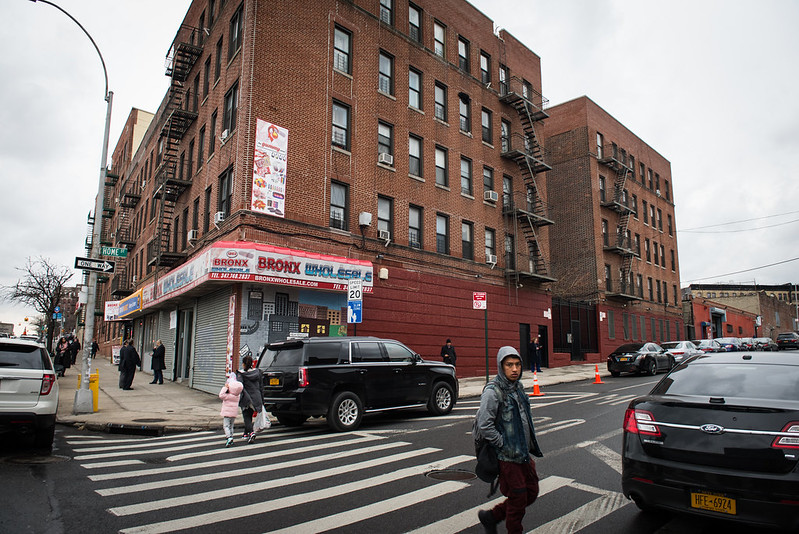
An economic crisis is upon us (photo: Edwin J. Torres/Mayor's Office)
For millions of American families, making rent each month is a familiar struggle: last October, a new analysis found that half of American renters were spending more than they could afford on monthly rent payments. But now, with the COVID-19 pandemic ushering in a new economic crisis and the real unemployment rate at its highest level since the height of the Great Depression, America’s housing affordability crisis is a true economic emergency. An unprecedented number of households will be newly unable to pay rent – and that threatens our whole economic system.
An emergency of this magnitude requires a swift and massive response from the federal government, which thus far has not materialized. As a way to press the issue, some are calling for a statewide rent strike in New York. But this approach will harm the affordable housing stock and the tenants who live in it. Rent is required to keep the buildings maintained, staffed, and clean. Rent strikes by tenants who are able to pay also hurts the ability of an owner to help those tenants who really need it.
This problem will require a multifaceted solution set, but must be centered around direct assistance to renters in the form of flexible emergency rental assistance and far more robust stimulus payments.
It is clear that renters need immediate help: last month, a nationwide survey by the National Multifamily Housing Council found that just 69 percent of American renters paid their rent by April 5, a year-over-year decline of 12 percentage points. While the figure rose to 84 percent a week later, there is evidence that these trends are more pronounced in the areas hardest-hit by the coronavirus, like New York City.
There is no question May will be worse. The national economic crisis has deepened, with tens of millions more out of work, and those who were struggling a month ago are likely facing even tighter budgets today. That is a real threat not just to the individual families but also to our entire economic system.
The affordable housing stock has thinner margins and less cash flow than its market rate counterparts and tends to have less in reserves. Many New York State Association for Affordable Housing (NYSAFAH) member buildings have already seen far lower levels of rent collection than the surveys of residential buildings as a whole have reported.
Rent payments ensure that families live in quality apartments maintained with basic services. It pays the salary of the building service workers who maintain sanitary conditions. Crucially, a suspension of rent would also freeze liquidity that is used to build the affordable and market-rate housing New Yorkers, and Americans across the country, desperately need to ease the housing crisis in the first place.
Rental assistance will keep that system in place while also protecting the most vulnerable among us. By building on the foundation set by the Emergency Solutions Grant (ESG) program, that assistance can be rapidly distributed, providing immediate housing security to American renters while preserving the sanctity of their buildings.
The fight ahead will not be easy, but it is absolutely necessary. We must all band together and raise our voices as one to demand the real protections that American renters deserve.
***
Jolie Milstein is the president and CEO of the New York State Association for Affordable Housing. On Twitter @NYSAFAH.
***
Have an op-ed idea or submission for Gotham Gazette? Email This email address is being protected from spambots. You need JavaScript enabled to view it.
The Pandemic Preys Upon Pollution’s Victims and Shows the Power Path Ahead
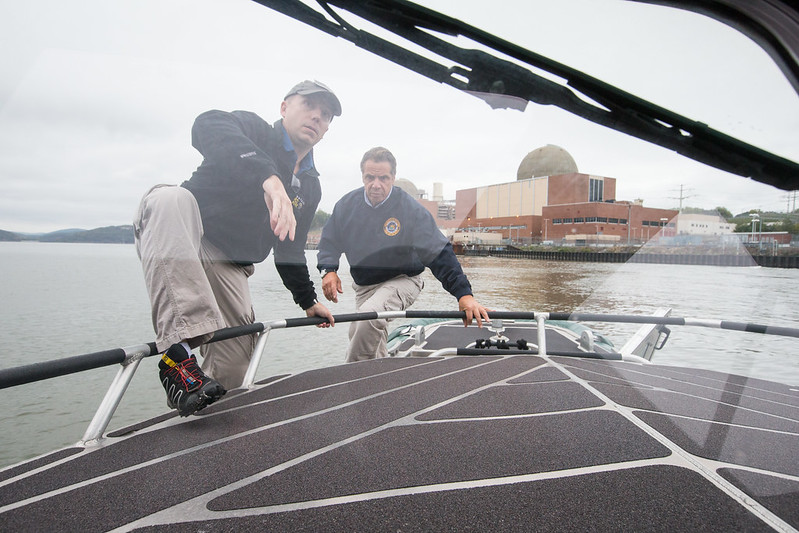
Governor Cuomo near Indian Point (photo: governor's office)
A silent and invisible killer, the novel coronavirus attacks the most fundamental human function that sustains life: our ability to breathe. To breathe properly, human beings need healthy lungs and clean air, specifically oxygen. And if lungs are compromised, there’s an even greater need for clean air.
As deaths in New York from COVID-19 surpass 17,000, those living in the pandemic epicenter face the compounding threat of substantially increased air pollution due to the imminent closure of one of the state’s largest carbon-free sources of power, the Indian Point nuclear power plant. The replacement power, largely derived from new and existing gas-fired power plants, will not only generate pollutants hazardous to human health, but will also (conservatively) emit 10-15 million tons of greenhouse gas emissions (GHGs), measured in carbon dioxide equivalents (CO2e), each year.
Greenhouse gases, which contribute to global warming, are invisible killers, much like COVID-19. For New Yorkers, air pollution and global warming are a double-whammy. It becomes a devastating and deadly triple-whammy for New Yorkers coping with COVID-19. If “Job one is saving lives,” as Governor Cuomo has said, then Indian Point must remain open.
We applaud the governor’s deference to science, data, and qualified professionals in deploying bold policies to respond to the pandemic. His recent prowess for data-driven decision-making is how all policy should be formulated. “Give me the facts,” he said of his mantra at a recent press conference. Facts are indeed the best antidote to irrational fear and anxiety.
While special interest groups such as Riverkeeper have spent years fear-mongering about Indian Point specifically, and nuclear power in general, here are the simple facts.
New York City is the second-largest consumer of power in the world, using 53 terawatt-hours per year. Indian Point generates 80% of the region’s carbon-free grid power. Generating the equivalent power from fossil fuels would increase the entire state’s electricity sector greenhouse gas emissions by 27-29%, rendering New York’s newly-enacted climate goals impossible to achieve.
“Natural” gas is mostly methane, which has 86 times the global warming potential of CO2 over a 20-year time-frame. A new analysis by the National Oceanic and Atmospheric Administration (NOAA) finds methane levels at an all-time high at 1875 parts per billion, the highest levels since record-keeping began in 1983. Most alarming, however, is that last year saw the single biggest increase in two decades. This accelerating rise in GHGs is a fact that is now keeping climate scientists up at night.
Burning fossil fuels also generates other harmful pollutants in the form of particulate matter. Fine particulates -- especially those with a diameter smaller than 2.5 microns (PM2.5) -- are particularly dangerous to the human body because they deplete lung capacity, and can pass from the lungs into the bloodstream. A new Harvard Study just released shows that long-term exposure to even a slight increase in pollution of just 1 microgram per cubic meter of PM 2.5 increases COVID mortality in a population by 15%. These results aren’t surprising. We know that comorbidities for COVID, such as hypertension, heart disease, and respiratory illness, are also associated with exposure to air pollution.
Most methane used in New York comes from fracking in neighboring Pennsylvania. Governor Cuomo recently banned fracking (for the second time - ‘permanently’ now), citing the threats of air and water pollution that it posed to New Yorkers. However, just like COVID-19, pollution does not recognize borders. Indian Point’s closure will plug New York City directly into Pennsylvania fracking fields, ensuring that New Yorkers will face even greater adverse impacts from fracking, in spite of the ban.
But of course the greatest impact will be on New Yorkers living near those gas power plants: communities of color; the same communities disproportionately impacted by COVID-19. Data released by the Centers for Disease Control (CDC) just days ago indicates that African-Americans represent 30% of COVID patients though they are only 14% of the population. Further analysis by the Associated Press found that one-third of all COVID deaths were African- American people.
In Orange County, as COVID-19 cases skyrocket a new fracked-gas plant, CPV Valley Energy Center, prepares to ramp up when Indian Point is closed. CPV is surrounded by 14 environmental justice communities. Orange County is also home to a large number of New York City first responders, who have also been disproportionately impacted by COVID. Ironically, many of them moved to the area after September 11, 2001, specifically for its once-pristine air quality.
After losing a sustained battle to stop CPV, the community now monitors their air quality daily with devices that measure PM 2.5. They’ve seen levels spike to as high as 180 micrograms per a cubic meter. When the plant is powered off, the meters read 0 -- a rare day they can take a deep breath. With CPV prepared to provide 678 MW of Indian Point’s 2000 MW baseload power, it’s unlikely they will see days like that again.
In New York City, the dense housing projects in the shadows of Astoria Gen, East River Gen, and Ravenswood power plants already have some of the highest asthma rates in the country, a comorbidity for COVID. They have some of the highest concentrations of COVID cases as well. Along with CPV, these dirty old power plants will likely be called upon to make up for Indian Point’s lost electricity.
52,000 people die every year in the United States due to pollution from fossil fuel power generation, while nuclear power saves lives. Globally, by displacing fossil fuels, nuclear power has prevented more than 2 million air pollution-related deaths. While Indian Point has provided safe, reliable carbon free power for over 50 years, irrational fear peddled by fossil fuel interests has prejudiced public perception. As an ambassador of scientific truth, we urge Governor Cuomo to correct that misperception.
The inconvenient truth is that New York plans to shut down Indian Point years before it can even hope to build enough reliable renewable power downstate, ensuring carbon lock-in for decades to come. It’s a catastrophic case of putting the cart before the horse. In the midst of a widespread pandemic and fast-approaching climate collapse it is a tragic blunder.
Melissa DeRosa, Cuomo’s executive secretary, recently commented on the importance of “being able to evolve and change in real time as facts and circumstances change.” The science is clear. Pollution plus a pandemic don’t mix. More lives will be unnecessarily sacrificed if Indian Point closes.
COVID-19 should caution us all that the laws of the natural world supersede the laws and desires of human beings; that we exist ultimately at their mercy. We cannot bend math and physics to our will. As the 50th Earth Day remembrance just again raised awareness of an even greater looming crisis, climate change, we should use this opportunity to recalibrate and “evolve” within the mandates and limits of nature.
***
Pramilla Malick is the Chair of Protect Orange County. Jim Hansen is Director of the Climate Science, Awareness and Solutions Program at Columbia University’s Earth Institute.
***
Have an op-ed idea or submission for Gotham Gazette? Email This email address is being protected from spambots. You need JavaScript enabled to view it.
Ferries Will Play an Even More Important Role in the Pandemic’s Aftermath
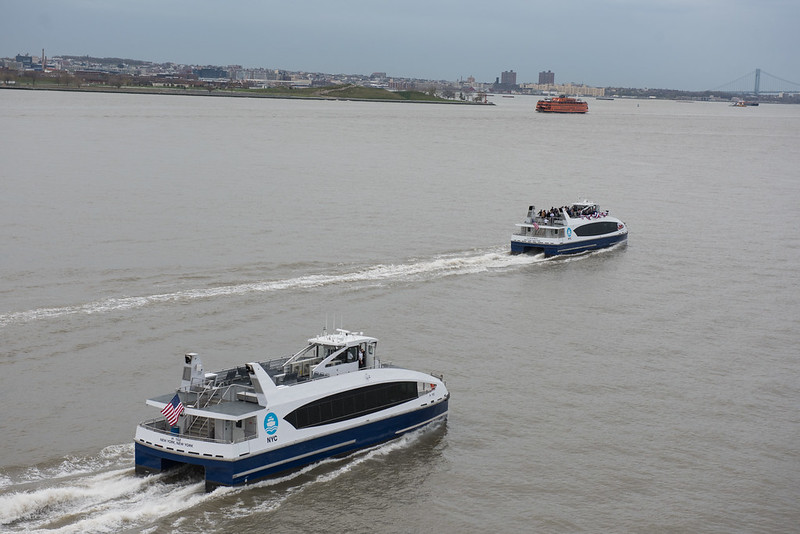
NYC Ferry program could become more important (photo: Michael Appleton/Mayor's Office)
There’s no doubt we’ll see changes in almost every facet of our daily lives after the coronavirus pandemic, but perhaps none will be as dramatic as the answers to the question of how New Yorkers will move safely around the city, including in our travels back-and-forth to work. Studies show that even if we drastically reimagine our economy, roughly two-thirds of employees -- at the very least -- will still need to commute, and the subways have been the lifeblood of the city for a century.
The subway system will remain the lifeblood of our city, and will undoubtedly adapt as best it can to new standards of safety and health in New York. But a quiet transportation revolution has been taking place in recent years that has altered thousands of commutes by taking advantage of one of our city’s greatest attributes, which can also help during our coronavirus-altered reality.
That revolution is the resurgence of our waterways and the robust and resilient ferry service that has come along with it. All up and down the East River and other points in Brooklyn with NYC Ferry, and to New Jersey and up the Hudson River with New York Waterway, ferries have been providing safe, efficient, and convenient trips for millions of commuters. NYC Ferry alone, in three short years of operation, has served almost 20 million riders.
As COVID-19 continues to change the fundamentals of human interaction, it’s become clear that these ferries provide a trip that is also far safer and healthier than other modes of transportation, largely because of their design and the federal rules that ferries operate under, which ultimately allow for more social distancing. The continuous monitoring of public spaces, by crew that today are wearing personal protective equipment (PPE) and undergoing daily temperature checks, are able to provide a more thorough upkeep and cleaning of the commuter space compared to what can be done on other modes of public transit.
Ferries are also flexible in a way that the subways and buses are not, from the vessels themselves to ferry networks as a whole. To begin, ferries have open upper decks, providing outdoor space. Riders aren’t hunkered down in a dark tunnel while on a ferry. Open decks mean fresh air (every day) and sunshine (most days). And there is enough room for everyone to stay safely apart. On NYC Ferry, for example, there are 165 seats on boats with a capacity for 149 passengers. That means even if the boat is 100-percent full, there are empty seats – seats that act as a buffer between passengers, in addition there is ample standing room indoors and on the outer decks. Same goes for the larger 349-passenger vessels.
Similarly, ferry systems can provide flexibility and ease of implementation that other transit systems lack. New routes can be added without the cost or disruption of building new subway tunnels, and vessels can be interchanged with relatively little disruption to meet demand. Due to anticipated budget cuts, overnight Staten Island Ferry service is expected to be scaled back, but essential workers will still require an affordable and convenient method of transportation. The smaller vessels operated by NYC Ferry, which is already set to expand to Staten Island later this year, could effectively and efficiently replace the overnight Staten Island Ferry service at the current overnight ridership demand, until the budget and demand allow a return to regular overnight operations.
The boats can also be re-configured to have more room for bicycles, which will likely be used even more after the pandemic subsides as commuters stay off the subway and look to other ways to commute.
On NYC Ferry, there are ADA-accessible, full-service restrooms that allow passengers to wash their hands. And hand-sanitizer stations are installed on all vessels along with notices to remind riders about CDC-recommended precautions individuals can take to stop the spread of germs.
At the end of the day, New Yorkers will need all the mass transit options they can get, including ferry service, which is relatively simple and efficient to scale up as we conform to what will likely be new social distancing norms for the foreseeable future. The waterfront’s role will continue to grow, but now with a sense of spatial necessity. But perhaps that greatest value ferries can provide? Each passenger on a ferry is one less passenger on a subway and in this new reality, when it comes to space, it’s quality over quantity.
***
Thomas J. Grech is President & CEO of the Queens Chamber of Commerce. On Twitter @QueensChamber.
***
Have an op-ed idea or submission for Gotham Gazette? Email This email address is being protected from spambots. You need JavaScript enabled to view it.
The Governor’s Clemency Negligence
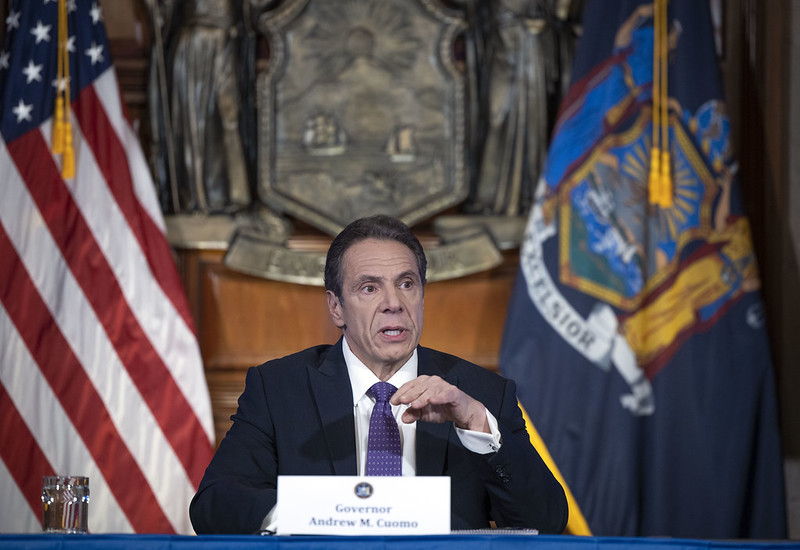
Governor Cuomo (photo: Mike Groll/Office of Governor Andrew M. Cuomo)
At his daily coronavirus press briefing on Sunday, April 26, Governor Cuomo was asked whether he had any plans to grant broad clemencies to people in prison, particularly to vulnerable populations. His testy and dismissive response – “How about if they are violent and just started their sentence?” – was telling. Presumably, the governor meant to remove from consideration people he believed remained a threat to public safety and had not been sufficiently punished.
The reporter’s question was ultimately about the perilously unsafe conditions in New York state prisons as nearly 1,300 staff and incarcerated people have already tested positive for COVID-19. The governor’s apparent disregard for anyone recently convicted of a violent crime is reminiscent of times when convicted people were sent to places like Devil’s Island where leprosy and other diseases flourished, and tens of thousands of incarcerated people died.
Public health officials in New York, nationally, and all over the world have cited prisons as petri dishes for the spread of the virus, and have called on government leaders to release people so that it becomes somewhat possible to maintain social distance and stay alive in prison. Otherwise, especially for those the CDC defines as most at-risk from COVID-19, numerous prison sentences will transform into death sentences.
Even engaging in the clemency debate on the terms spelled out by the governor, what about releasing those convicted of violent crime who have served twenty, thirty, forty, or more years? Countless people in New York state prison have served decades, many defined by remarkable achievement and transformation.
They have completed, facilitated, designed, and implemented programs; they have obtained GEDs, associates, bachelors, and masters degrees; they have learned several trades; they have the support of people inside the prison and robust re-entry plans with family members who are waiting, and praying, with open arms for their release. And, to the governor’s stated concern about violence, they are older and, as every study ever done shows, have aged out of any likelihood of committing another crime. They are no threat to public safety, and have much to offer their families, communities, and society at large
Thousands of people in New York State prisons have submitted clemency applications, many well before the coronavirus outbreak. Many of the applicants are elderly. Many have health issues. Very few “just started their sentence.” Countless among them merited clemency in their own right before COVID-19 came behind the bars. Now, their meritorious applications are joined by the urgency of a public health crisis of untold magnitude.
While clemency is usually cast as an act of mercy or charity, at this moment it is a matter of life and death. The governor’s power to grant clemency is firmly rooted in the state constitution. It is well past time for Governor Cuomo to use it.
***
Steven Zeidman is a professor of law at CUNY School of Law. On Twitter @SteveZeidman.
***
Have an op-ed idea or submission for Gotham Gazette? Email This email address is being protected from spambots. You need JavaScript enabled to view it.
The ‘Wartime Budget’ New York City Needs
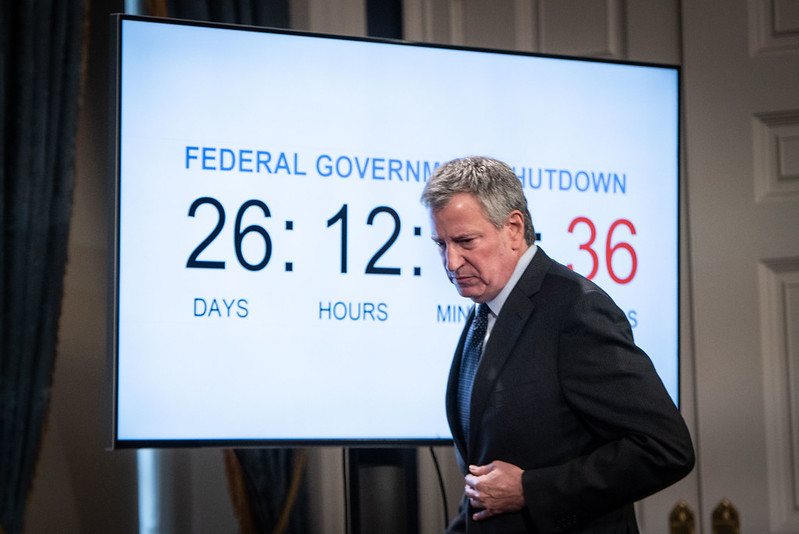
Mayor de Blasio is facing difficult budget choices (photo: Michael Appleton/Mayor's Office)
Mayor de Blasio called the Executive Budget he presented on April 16 a “wartime budget.” With New York City’s economy shut down virtually overnight and without a clear path or timeline to reopening, that is definitely what the circumstances require. But, we don’t quite have one yet.
Estimates of cumulative city revenue losses from the city’s budget office and outside fiscal monitors range from $7 billion to $15 billion for this and next fiscal year, but there is no precedent for the current situation so modeling on the experience of past recessions could well understate both the extent and the timeframe of the losses. Absent a large infusion of federal assistance, the best way to close the city’s budget gap is more and larger expense reductions, not tax increases or borrowing.
While the Executive Budget, which will form the basis for negotiations with the City Council, shows an overall year-to-year reduction of 3.6 percent from the budget adopted last year, it would increase city-funded expenses by 1.3% -- not as generous as the annual growth in recent years (which averaged 4.8% for most of de Blasio’s tenure) but not a cut. Significant withdrawals from reserves and the Retiree Health Benefit Trust as well as $2.7 billion in cost savings currently make up for the anticipated loss of tax revenue. But most of these are one-time savings (and many caused by the impact of the virus and stay at home order); if tax revenue losses are higher and last longer because the economy doesn’t bounce back quickly, these actions will not be sufficient.
Moreover, there is little indication that the City Council is on a “wartime” footing and will refrain from its usual demands for more spending. In its formal response to the mayor’s Preliminary Budget, issued after the virus shutdown began, the Council listed many areas it believes should be fully funded and proposed adding more than $1.4 billion in new spending but suggested only half as much in spending reductions to offset it (and some of those savings ideas have been incorporated into the Executive Budget to offset current expenditures). And new legislation proposed by the Council last week, characterized as a coronavirus aid package, would impose new costs on businesses that would make it even more difficult and costly for them to operate and hence, to pay their employees and taxes.
The mayor is holding back on more cost-cutting in the hopes that the federal government will come through with financial assistance to help close city and state budget gaps. But the most recent aid package passed by Congress didn’t include state and local aid and Senate Majority Leader McConnell and other Republican legislators say they are not in favor of this type of assistance. Indeed, McConnell effectively said ‘Let ’em go bankrupt.’
Federal budget relief for states and localities is clearly warranted and some will eventually come through, but it will be preceded by a fraught, ideological battle about blue states’ high taxes and overspending and cannot be counted on to happen in time for final New York City budget adoption (on or before June 30). And New York State, which is facing its own $13 billion revenue loss, is not going to come to the city’s rescue. Indeed, aid reductions and cost-shifting by the state could make the city’s problem worse. So there needs to be a more serious plan to ensure that the city can balance its budget with little or no federal help.
It is difficult to cut city programs and services. Each one has a constituency of supporters who believe fervently in its importance. Many of the cuts and reductions in the Executive Budget, though relatively small and temporary, have already been decried by those who especially care about them, e.g. advocates of recycling urge restoration of the costly organics collection program; social service youth care providers denounce the suspension of the summer employment program. One of us is especially pained by the cut to a nationally recognized college completion program she helped create, CUNY ASAP.
But the city simply does not and will not have the money to keep doing everything in an annual budget that has grown to well over $90 billion. There will have to be deeper cuts and sacrifices of favored programs and activities than the Executive Budget proposes, at least for now. Labor contracts should be re-evaluated in light of the pandemic and efforts to achieve more productivity negotiated with public employee unions. Otherwise, the city risks having to take more draconian measures, such as laying off public employees and imposing cuts to essential services as the coming year unfolds.
Two things that should not be done except as a last resort are raising taxes and/or borrowing to pay operating expenses. It should be evident to the mayor and the Council that raising taxes now would only exacerbate the risks to the already fragile revenue base, as many business owners consider closing and the pandemic is causing many people to consider leaving New York.
Nor is borrowing a good idea. Borrowing money to fund capital projects is appropriate because the value of the expenditures for things like roads, school buildings, and water mains – their ‘useful life’ – lasts for years and it makes sense to pay for them over a long time period. In contrast, paying for current expenses like employee salaries pushes the responsibility for payment into the future, burdening taxpayers for years with debt service for services that have already been consumed.
Every $1 billion in borrowing now will cost at least $65 million a year for debt service every year the loan is outstanding (based on 5% interest on a 30-year loan). Especially now, every penny of the money that would go to interest is needed to pay for the costs of operating city agencies.
There will undoubtedly be many, including Council members and public employee unions, who endorse the borrow now, pay later approach because it avoids making hard decisions in the short run and allows city services and agencies to keep operating as if there is no problem. But if the economy and its tax revenue do not bounce back, the gap between costs and income will remain and more borrowing will be needed to close it.
This is a particularly frightening prospect to those, like one of us who was a First Deputy Budget Director in the mid-seventies, who remember the massive retrenchment and downsizing of city government during the fiscal crisis of that time. Instead of aligning the cost of city services with its revenue, it had borrowed money to pay its operating expenses year after year, until eventually institutions would not loan any more money because they realized the city would never be able to pay it back. There was literally not enough cash on hand to make payroll. (See this story for a good summary, with warning signs for today, of the fiscal crisis of the 1970s.)
Many felt it was acceptable when Mayor Bloomberg borrowed $2.1 billion to pay operating expenses right after September 11, 2001. But the nature of that crisis was quite different than what we face now. Only lower Manhattan was directly impacted and the rest of the economy, though suffering temporary setbacks, was able to quickly recover, so the city’s coffers could be replenished. In addition, Mayor Bloomberg instituted significant cost controls, including personnel reductions. The Council also agreed to an 18% increase in property taxes, and the state Legislature extended a 14% surcharge on the city personal income tax, neither of which would make sense in the current situation.
If, instead of making tough decisions about curbing expenses now, the mayor and Council decide to try and kick the can down the road by borrowing, the state Legislature should deny permission unless and until the city can demonstrate that it is holding the amount borrowed to an absolute minimum by taking every other possible step – including savings on personnel costs – to reduce the city-funded operating budget. If borrowing is permitted, it should be conditioned on the creation of a ‘control period’ during which the city’s finances are subject to oversight and intervention by the Financial Control Board, created during the ‘70s fiscal crisis to help ensure that the city adopted balanced budgets and sound financial management. Since 1986 the Board has served in a monitoring role, but this could be the time to bring it back into action.
Correction (May 7): In the original version of this piece, we incorrectly stated that after 9/11 Mayor Bloomberg negotiated a multi-year no-raise contract with the teachers’ union. That contract was negotiated during the recession in 2008, and mention of it has been removed. Mayor Bloomberg signed a 30-month contract with raises following the city-wide pattern of 4% a year with the teachers in early 2002 when he was pursuing Mayoral control of the school system. But, as we said, the city budget adopted post 9/11 did include significant cost cutting, including early retirement measures, attrition, and difficult and unpopular agency spending reductions such as curtailing plastic and glass recycling.
***
Carol Kellermann was president of Citizens Budget Commission from 2008 through 2018. Norman Steisel was a First Deputy Mayor of New York City, Sanitation Commissioner, and First Deputy Budget Director, all between 1974 and 1994.
***
Have an op-ed idea or submission for Gotham Gazette? Email This email address is being protected from spambots. You need JavaScript enabled to view it.
Cuomo's Density Dodge: Pandemics Aren’t Anti-City, Failure to Act Early Is
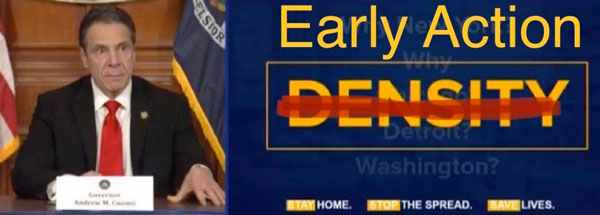
An altered image from one of Gov. Cuomo's briefings (by Aaron Carr, the author)
Dear fellow urbanites, city dwellers, and city lovers,
I regret to inform you that the heart and soul of New York City is under attack. And not just by COVID-19, which, as of April 27, has taken the lives of an astonishing 16,936 New York City residents, but by fictional statements made by our own governor, Andrew Cuomo, who has deceptively blamed the spread of this infectious, vicious, and deadly disease primarily on our city's population density.
The governor deserves commendation for often being a voice of reason in this crisis, but he deserves condemnation for failing to acknowledge his own mistakes and for attempting to distract from them by scapegoating.
Before a national audience of millions, the governor accuses our city’s density of being “dangerous” and “destructive.” But he’s wrong. Density is not dangerous and destructive –– a failure to plan, a failure to prepare, and a failure to act early is what has allowed COVID-19 to wreak devastation on New York. (Unfortunately, Mayor de Blasio has also relied heavily on this argument)
It is certainly fair to ask, “Isn’t density a factor?” And of course density is a factor, it’s just not the factor, and in no, way, shape, or form the most important factor.
California, for example, has many densely populated cities, yet responded much quicker than New York to the novel coronavirus. Governor Gavin Newsom’s stay-at-home order (the first in the country) was implemented on March 19 when California had just 1,006 confirmed cases. Governor Cuomo, on the other hand, delayed implementing such a decision until March 22 when New York had a whopping 15,168 confirmed cases.
Just consider for a moment the millions of New Yorkers who likely came in contact with each other during those few days — going to work, walking on crowded sidewalks, riding a packed subway car, rubbing shoulders, coughing, touching common surfaces, and all the while transmitting this highly infectious and contagious disease.
In an interview with the New York Times, Dr. Thomas R. Frieden, the former head of the Centers for Disease Control and Prevention and former commissioner of the city’s Health Department, said “if the state and city had adopted widespread social-distancing measures a week or two earlier, including closing schools, stores and restaurants, then the estimated death toll from the outbreak might have been reduced by 50-80 percent.”
So, it should come as no surprise that, despite accounting for just 2.5% –– one-fortieth –– of America’s population, New York City represents nearly one-third of America’s COVID-19 fatalities.

Yet, instead of taking responsibility for his slow response, Governor Cuomo has launched a scapegoat campaign, blaming New York City’s natural identity -- our density -- as the source of the problem.

But the data, while correlational, strongly suggests that the governor is wrong:
If density is so destructive, there should be a strong positive correlation between the density of the five boroughs and number of COVID-19 fatalities and cases -- particularly in Manhattan, which is not just the densest part of New York City, but of America.
There isn’t.


If density is so destructive, New York City should not have 770 times the fatalities of San Francisco -- the second-densest large city in the United States -- despite having only 10 times the population.
But we do.

If density is so destructive, New York City should not have 1,210 times the fatalities of Singapore and 8,468 times the fatalities of Seoul (846,700% more), which is in close proximity to China, has a million more people, and is twice as dense as New York City.
But it does.

If density is so destructive, a single senior center in Cobble Hill, Brooklyn, wouldn’t have had more deaths than entire cities and countries. But it has.

If density is so destructive, why does New York City have 9,621 more deaths than Japan, South Korea, Australia, Thailand, Taiwan, Germany, Hong Kong, Singapore, New Zealand, and Austria combined, while all these countries are home to dense cities and a total population of 400 million people.


Here’s the rub: Cuomo’s attack on density actually has little to do with density and everything to do with politics. Cuomo is a master politician, and like any master politician, he is a master of words. And, Cuomo -- always choreographed and calculated -- chooses his words with precision. In this case, by intentionally conflating the word “density” with “crowding,” which are two very different things. Density refers to the number of people per square mile of land. Crowding is when a large group of people convene together in a small space.
In a pandemic, it’s crowding -- not density -- that’s destiny.
Take for instance, the Smithfield Foods pork plant in Sioux Falls, South Dakota. More cases have been linked to this one plant than all of Seoul, South Korea, a city with 9.7 million people, in a country that at one point had the second most COVID-19 cases in the world.

The problem at the Smithfield Plant wasn’t density, it was crowding. And the same rule applies to cities in general.
San Francisco, for example, did not become a model for the country by reducing density, but by reducing crowding -- through aggressive, decisive, early action.
The reason Cuomo is putting his eggs in the density basket is because, unlike crowding, he can’t control density and therefore he can’t be blamed for the outcome. But knowing that he could control crowding early, and didn’t, the question then becomes, “why did Cuomo delay?,” and that is the last question Cuomo wants to answer.
To be sure, the majority of the blame falls on the incompetence, ineptitude, and callousness of the Trump administration, for, among other things, ignoring multiple warnings from his intelligence agencies and failing to provide states like ours with the support so desperately needed. History will not be kind to the president.
But in our decentralized system, it is governors that have jurisdiction over stay-at-home orders and the power to enforce them. Furthermore, the scientific literature demonstrates that early social distancing can be crucial in combating infectious disease.
There is no doubt that Governor Cuomo deserves praise for the exceptional job he has done keeping the public at ease and our city, state, and nation informed. But if we are going to learn lessons from COVID-19 and be better prepared for the future, we need an honest assessment of what went wrong. One that leads to a simple question of why 16,936 people have died in New York City, when only 22 have died in San Francisco, 4 in Hong Kong, and 2 in Seoul, South Korea.
The answer is not density -- it’s planning, preparation, and early action.
***
Aaron Carr is Founder and Executive Director of Housing Rights Initiative. On Twitter @aaronAcarr.
***
Have an op-ed idea or submission for Gotham Gazette? Email This email address is being protected from spambots. You need JavaScript enabled to view it.




